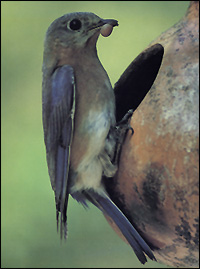Introduction
If someone were to ask you to describe a bird, you probably would say it is a feathered creature that flies and lays eggs. These three characteristics do describe most birds, but the only characteristic that belongs exclusively to birds is the presence of feathers. Just as all mammals have hair, all birds have feathers.
It is true that all birds lay eggs, but so do many other creatures – reptiles, amphibians, insects, fish, and even a couple of mammals. All birds have wings, and most of them have light-weight bodies and strong wing muscles that make them well suited for flying. However, there are some birds that cannot fly, such as the ostrich and the penguin. Their wings serve different purposes. Penguins use their wings as flippers to help them swim under water, and the wings of ostriches help them keep their balance as they run. The presence of wings and the ability to fly are not exclusive to birds, either. They are shared by many insects, as well as the bat, which is a mammal.

A scientist would describe a bird as a warm-blooded (having a constant body temperature even when the temperature around it changes), bipedal (two-footed), air-breathing vertebrate (animal with a backbone), with forelimbs modified into wings or winglike structures and a body covered with feathers.
Birds come in all sizes, shapes, and colors. They range from the tiny hummingbird to the giant ostrich. The smallest, the Cuban bee hummer, is only about 2-1/2 inches from bill tip to tail tip, and it would take about fourteen of them to weigh one ounce. The ostrich, which can weigh up to 340 pounds when full grown, stands about eight feet tall. Among the largest flying birds are the Andean and California condors, which have a wingspan of ten feet and weigh about 25 pounds, and the wandering albatross, which has an eleven-foot wingspan from wing tip to wing tip.
Different species of birds eat different kinds of food, and nature has provided them with different kinds of bills to make their food gathering easier. For example, the cardinal has a short, stout bill for cracking seeds. The hawk has a sharp, curved bill that is used to tear apart the animals it catches for food. The hummingbird's long slender bill helps it sip nectar from flowers.
Some people think modern-day birds can trace their ancestry back to the prehistoric pterodactyl (ter-ah-DAK-tel), but scientists agree that the pterodactyl was a flying reptile – not a bird at all. Its wings were similar to those of the bat, and it had no feathers. The true ancestor probably was a reptilelike bird called the Archaeopteryx lithographica. Its scientific name comes from the Greek words meaning "ancient wing" and "imprinted on stone." The fossil remains of the archaeopteryx (ar-key-op-tah-ricks) were found in a limestone quarry in Bavaria about a hundred years ago.
A study of the fossil revealed that the reptilelike bird was about the size of a crow. It had a short, blunt, skinny bill and teeth, which it probably used to eat fruits and berries or possibly lizards and insects. It had the long bony tail of a reptile, but the tail was fringed with large feathers – a pair growing from each of its twenty-three tail vertebrae. Its feet and legs were very similar to those of the modern-day crow. Its feathered wings were small and weak-looking, and it did not have a breast bone large enough to support powerful flight muscles. For this reason, scientists believe it was a flutterer or glider. The front of each wing had three fingers, each armed with a claw. These fingers probably helped the bird climb, pry into crevices for food, or grasp a branch to bring fruits or berries closer to its mouth.
It is estimated that this reptilelike bird lived about 130 million years ago during the time when dinosaurs roamed the earth. Evolutionary changes during the passing millions of years slowly changed this prehistoric creature into the bird we know today. As a probable carry-over from its reptilian ancestry, modern-day birds still have scales on their legs and feet, but they no longer have teeth.
In the following pages you will learn even more about birds.
Ilo
Hiller
1989 – Introduction: Introducing Birds to Young
Naturalists. The Louise
Lindsey Merrick Texas Environment
Series, No. 9, pp. 3-4.
Texas A&M University
Press, College Station.